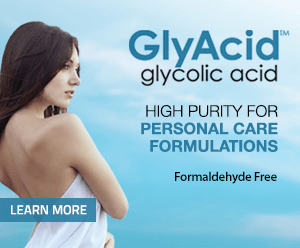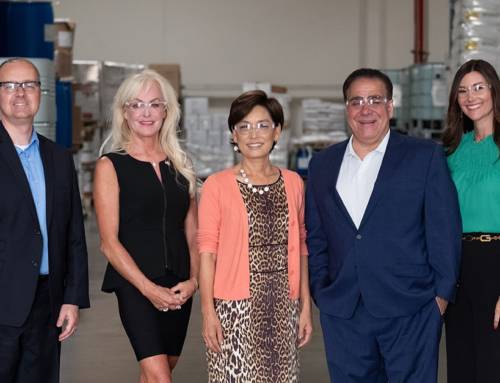Glycolic Acid, An Industry Perspective: An Interview With Jeff Weeks
August 20, 2020
Coast Southwest is continuously seeking high-purity specialty chemicals in response to the growing preferences and requirements of the personal care marketplace. We asked our supplier, Jeff Weeks, CEO of CrossChem and an industry leader with more than thirty years’ experience, much of that in the pharmaceutical industry, to talk about two strong and seemingly somewhat contradictory trends in personal care — ingredient purity and glycolic acid in skincare and anti-aging regimens.

Coast Southwest: Glycolic acid is one of the most popular actives in anti-aging formulations with strong consumer recognition. At the same time, formulators and consumers are highly focused on ingredient purity. Yet, glycolic acid is typically produced with formaldehyde.
JW: For decades the prevailing glycolic acid production has been through the carbonyl synthesis of formaldehyde. Initially, formaldehyde was not considered harmful and the applications were likely never envisioned for personal care. However, in the late 1980s, the EPA listed formaldehyde as a probable carcinogen. In 2011, it was formally listed by the Department of Health and Human Services. Around the same time as the EPA listing, glycolic acid was introduced into personal care applications as an anti-aging, anti-wrinkle active and has continued to grow globally since.
As CrossChem was being spun out from Rohm and Haas, your company’s founding team decided to put your decades of experience creating specialty chemicals to work on developing a glycolic acid that was formaldehyde-free.
JW: Yes. CrossChem formed in 2001 with chemistries primarily serving the pharmaceutical and aerospace industries. In 2004, we identified the limitation of a formaldehyde-based glycolic acid and began working on an alternative synthesis route that did not use formaldehyde.
Given our experience in developing and synthesizing products for the pharmaceutical industry, we discovered an acid saponification process that allowed us to provide the marketplace with a formaldehyde-free glycolic acid alternative.
One of the key questions (and risks) was efficacy. Could a non-formaldehyde-based product provide the molecular and application efficacy as a formaldehyde-based product? With the help of independent labs, global downstream customers, and the application of our material within their formulations, we have demonstrated efficacy across hundreds of formulations among the biggest brands globally.
And you have been delivering that high-purity product for the last ten-plus years.
JW: We have. It has been our experience that when presenting formulators with two competing technologies, one that uses formaldehyde in its synthesis, is more than fifty years old, and was likely never intended for personal care, and the other a formaldehyde-free technology delivering on the fundamental tenets of clean beauty, the choice has been pretty definitive. Given the two technologies, most seem to prefer our solution.
As a formulator, would it be hard to switch from my current glycolic acid to one that is formaldehyde-free?
JW: Change is hard. We recognize the time, effort, and cost in the development of personal care formulations. We also understand chemists have a level of comfort with current suppliers and product lines, which is why we have spent the past decade methodically traveling the globe meeting with large and small brands presenting our technology. Our emphasis has been providing the chemistry differences with analytical support. We have shown through FTIR scans that while our chemistries differ, our finished product is a molecular match with traditional chemistries. GlyAcid® is plug-and-play. In addition, and with the help of our distributors like Coast Southwest, we have facilitated more than forty GlyAcid® starting point formulations to expand creative new possibilities. In the effort, many chemists around the world have already made the decision to move to our glycolic acid alternative.
One last question. GlyAcid® is one of CrossChem’s first products and it is such a success. What is your company’s “secret sauce?”
JW: We feel fortunate that one of our first post-Rohm and Haas product development efforts has proven successful in domestic and global markets. We have a well-defined understanding of who we are and what we do. That serves us in terms of efficient resource allocation. We are focused on those particular products where we have competitive chemistry and technology advantages to meet a specific, articulated need. Specifically those needs within markets with purity sensitive profiles.
About CrossChem
CrossChem is a Carlsbad, CA USA-based specialty chemical company. CrossChem launched in 2001 with the acquisition and spin-off of a Rohm and Haas Company product line by R&H commercial and technical managers. CrossChem excels in developing and producing versatile, extremely high purity specialty chemicals with CrossChem proprietary chemistries and process technologies. CrossChem products serve the personal care, aerospace, pharmaceutical, medical products, electronic materials, polymer and other purity sensitive industries and markets. Today, CrossChem utilizes three manufacturing facilities in the USA and one in China. With authorized distribution partners, CrossChem products are sold worldwide under the GlyAcid® and HiPure™ brands.
Pure Chemistry
For more than 40 years, glycolic acid has been predominately produced by either the carbonylation of formaldehyde or with glycolonitrile as a starting material. Both processes leave residual traces of formaldehyde in the finished commercial product. By contrast, CrossChem’s GlyAcid® is produced using a proprietary acid saponification and purification process that does not use formaldehyde while delivering a high purity glycolic acid in 57% solution, 70% solution and 99% crystalline.






